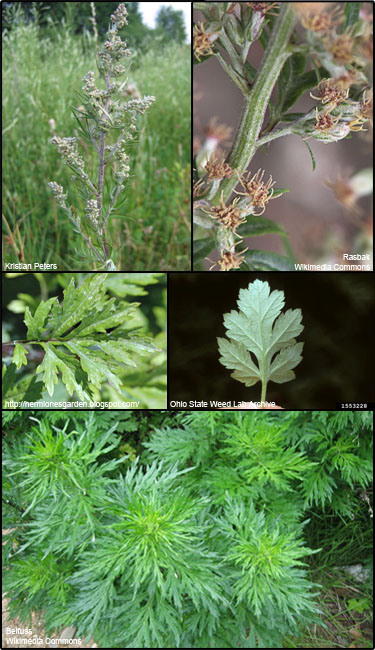Common wormwood (Artemisia vulgaris)
 Common Names: Mugwort
Common Names: MugwortDescription: Contains medically active ketones and alkaloids; Used for livestock feed.
Habit: Perennial with persistent rhizomes, ranges from 60-160 cm high, many thin lateral roots.
Leaves: 2-4 in long, 1-3 in wide; simple, alternate, distinctive aroma, deeply lobed and may lack petioles; undersides are covered with soft, white-gray hairs; upper leaf surfaces may be smooth to slightly hairy.
Stems: 5 ft in height, often reddish-brown in color, becomes woody with age, parallel grooved, ascending twigs covered with hairs.
Flowers: Inconspicuous, occur in clusters at the top of the plants, heads are 2.5-3 mm wide on short stalks, 7-10 purple female flowers, narrow tube-shaped corollas, 8-20 bisexual flowers.
Fruit and seeds: Viable seeds are rarely produced in North America.
Habitat: Native to Eurasia. Found in high elevation pastures, forest edges, valleys, hillside wasteland, ditches and roadsides.
Reproduction: Vegetatively by rhizomes.
Similar species: Garden Chrysanthemum (Leucanthemum maximum); Common Ragweed (Ambrosia artemisiifolia).
Monitoring and rapid response: Monitor fields, roadsides and disturbed areas. Credits: The information provided in this factsheet was gathered from Bugwood.org, the USDA PLANTS Database and the Virginia Tech Department of Forest Resources and Environmental Conservation VTree.
Individual species images that appear with a number in a black box are courtesy of the Bugwood.org network (http://www.invasive.org).Individual photo author credits may not be included due to the small display size of the images and subsequent difficulty of reading the provided text. All other images appear courtesy of Google (http://images.google.com).
Common Name: | Common wormwood |
Scientific Name: | Artemisia vulgaris |
Family: | Asteraceae (Aster) |
Duration: | Perennial |
Habit: | Herbs |
USDA Symbol: | ARVU |
